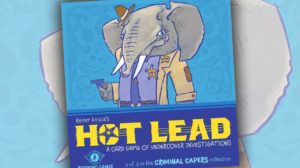I should start by telling you that the dice included with the dog-themed dice game Spots are custom. The pips are not perfect circles. They are irregular, meant to replicate the spots on a dog. This sounds frivolous, but it is deeply important. The pips are the first indication of how much this game cares.

The manual is an easy-to-follow, fully-illustrated comic book. “Dogs have spots,” it says. “Dice have spots,” it says. “Place your dice on the right spots. Complete your dogs to score them!” I’m charmed. Are you charmed?
Now look at the chunky cardboard Trick tiles, which govern the actions available on your turn. Fetch. Roll Over. Beg. They’re large, about the size of 3×5 index cards. They too are irregular, with non-squared edges and award ribbons of various shapes and colors jutting out on the right hand side.

Consider the red, wooden dog bones. Examine the Yard tiles, and notice that each yard contains different buried contents. The word that comes to mind in all of this is “tactile.”
Then, inevitably, you come to the dogs. The dogs are but a humble deck, but what a deck it is. Gretchen, in her rain boots and hat. Handsome with his stick. Honcho, who could be the head of this house anytime. Ursula, staring down a bee with the cool, cold, collected gaze of a terrified one-year old. Doog, who you can’t help but suspect is a cow. It’s not his fault. He wants to be a dog, and we should respect that.

Dog Training
The dogs in Spots are covered in those little titular dots, many of which happen to take the shape of pip formations from dice. What are the odds?
On your turn, you perform one of the six tricks set out at the start of the game, most of which allow you to roll some number of dice. Each trick has different rules governing how many dice you roll, and how many you have to place—that is, how many you have to put on open spaces on your dogs or, when that’s not possible, bury in your yard.
Walk is the basic rolling action. You roll two dice, place them, then you may choose to roll a third one. The tricks get more specific from there. Fetch has you roll eight dice and choose one number that appears amongst the results. You have to place all the dice that show that number. Guard has you name a number before rolling four dice. You discard any dice that show a number higher than the one you named. This is all spelled out in clear, plain English. No iconography here. No language-independence either, mind.
Other tricks get you more Treats, which can be used to re-roll, or more dogs, up to six. The more dogs you have, the more numbers you have room to place. Any dice you can’t place move to your yard. If you ever have more than seven pips in your yard, you immediately discard all dice you own, both from your yard and from your dogs. Risk.
Pushing your luck is, of course, part of any dice game. With the high potential consequences of busting, Spots would seem to discourage the behavior, but that brings us to scoring. There are two ways to secure your polished puppers. If you have completed canines at the start of your turn, you can elect to spend your turn scoring, removing the dice from your ready rovers and flipping them over. They’re yours now, and cannae be taken.
Scoring also happens immediately if you manage to finish the spots on all of your unfinished dogs. This happens even if the rest of the dice will cause you to bust. You place on your dogs first. That can cause a massive swing in a game that is a race to six, and it encourages players to take risks. Reward.

Sit, Ubu, Sit
Spots is a charming dice game. It immediately invites people to the table. Artist John Bond did a wonderful, wonderful job with the illustrations, which are full of character and humor. Children immediately start comparing what’s buried in their yards, and look through all the dogs in the deck as soon as you let them.
Co-designers Jon Perry (Air, Land & Sea) and design team Alex Hague & Justin Vickers (Monikers, Wavelength) have given us a good amount of content for such a small box. The tricks—Howl and Roll Over are always part of the setup to keep the game moving, but the other four change out—provide for enough variability to keep adults interested. How long it would hold up during adult game nights, I’m not sure, but it’s not aiming for that. This is a terrific family game, which is exactly what it wants to be. It’s certainly Best in Breed, if not quite Best in Show.












Minor correction: the immediate scoring does _not_ save you from busting. You have to place all the dice from a roll before you can immediate-score.
You do _not_ have to complete the entire trick, though. You can execute one roll of a multi-roll trick, immediate-score, and then execute another roll.
Thank you for the clarification, Harold! For some reason I always found that a bit confusing. Very helpful.